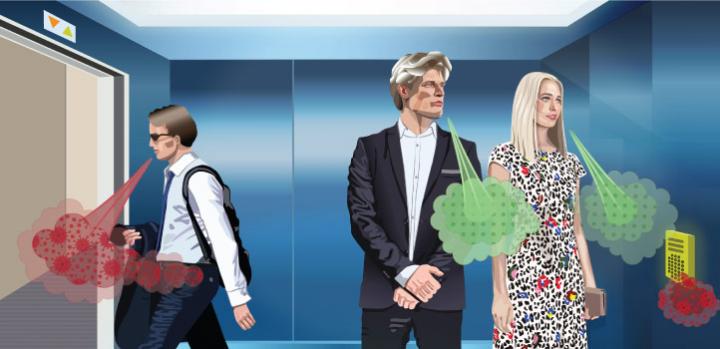How long do virus-laden particles persist in an elevator after a person infected with COVID-19 leaves? And is there a way to detect those particles? A group of electrical engineers and computer scientists at KAUST set out to answer these questions using mathematical fluid dynamics equations.
“We found1 that virus-laden particles can still be detected several minutes after a short elevator trip by an infected person,” says KAUST electrical engineer Osama Amin.
The team’s equations and breath simulations suggest that a biosensor’s ability to detect a virus improves when placed on an elevator wall that can reflect particles. Also, to protect future occupants, the amount of particles in the air can be reduced by making the other three walls absorptive.
“This kind of study requires input from researchers with varied expertise in theoretical channel modeling, system design and integration, and machine learning schemes,” says Amin.
In their previous work, they used equations to understand how exhaled molecules disperse in open spaces3. They also proposed4 a sensing system that can detect molecules exhaled from people’s breath at mass gatherings.
In their current work, they developed a model and simulations that describe what happens to molecules exhaled in breath within a closed room over space and time. Their modeling took into consideration the abilities of walls to absorb or reflect particles. Once their models were able to describe, solve and simulate virus-laden particle concentration in a small room over space and time, the researchers worked on calculating the probability of a biosensor being able to detect those particles.
The calculations assumed the deployment of a biosensor that uses antibodies to bind to a specific virus and initiate a signal. They also accounted for parameters such as aerosol sampling time and volume, sampling efficiency and the probability of the antibodies binding to a virus.
The team is now developing an aerosol sampling and detection prototype for organic chemicals exhaled in breath. “We also plan on proposing mechanisms that reduce the probability of infection in small spaces, including ventilation mechanisms, periodical air sanitization and the design of absorptive and reflective walls,” says Shihada.
###
Media Contact
Michael Cusack
[email protected]
Original Source
https:/
Related Journal Article
http://dx.





